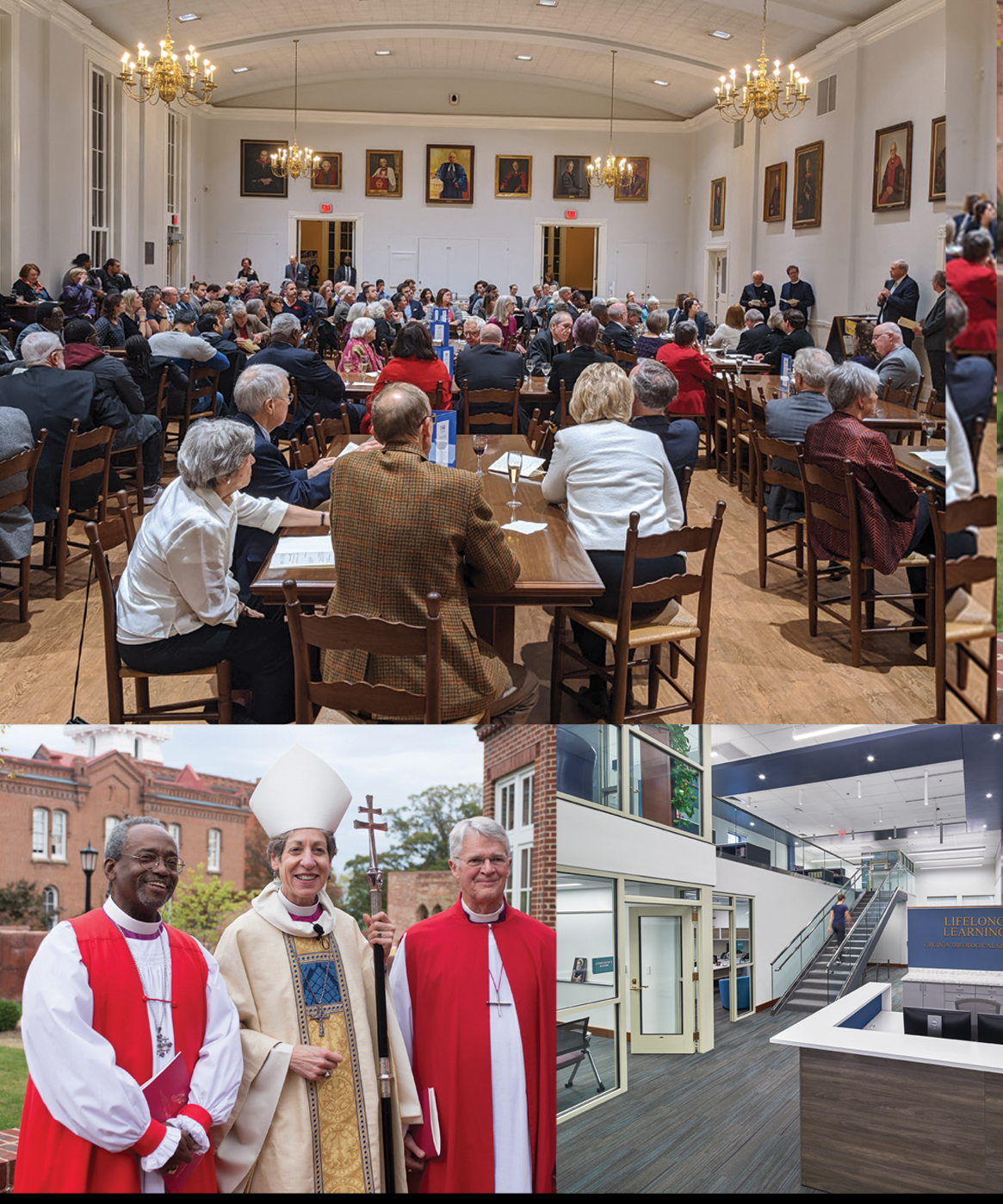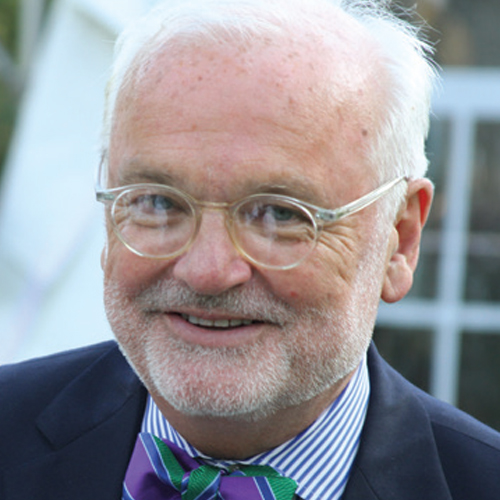 VIRGINIA THEOLOGICAL SEMINARY
VIRGINIA THEOLOGICAL SEMINARY

VTS was founded in 1823;
and in 2023 we mark a historic moment: 200 years of ministry and mission in The Episcopal Church and in the worldwide Anglican Communion. To “mark the moment” is not to “celebrate” but to remember well and to give thanks.
In the gospels of Matthew and Luke, we are given the Biblical words which are at the heart of giving thanks in our Christian tradition. We gather around a table to give thanks. We say in the prayer which is the Great Thanksgiving of the Holy Eucharist: “Let us give thanks to the Lord our God.” We also say: “Do this in remembrance of me.” We break the bread and drink the cup to “mark the moment” of the saving grace of our Lord’s life, death and resurrection. We proclaim the “mystery of faith”:
Christ has died.
Christ is risen
Christ will come again.
Whenever Christians gather, they give thanks and remember. Alice Walker writes: “‘Thank you’ is the best prayer that anyone could say. I say that one a lot. ‘Thank you’ expresses extreme gratitude, humility, understanding.” Walker, best known for her novel The Color Purple, has also given us a moving short story, “The Welcome Table.”
VTS is approaching its Historic Bicentenary as a “Welcome Table” moment with “extreme gratitude, humility and understanding.” We have “extreme gratitude” for the many ways God’s mission in the Church and world has been at the heart of VTS’ story. We are filled with “humility” for the many ways we have missed the mark and not proclaimed the Good News of Jesus Christ. We must think of the ways VTS participated in and encouraged a culture of enslaved persons in nineteenth century America. Ours is a history of great faith but also serious flaws.
We come to our Historic Bicentenary with an “understanding” of our past, even as that “understanding” is still being revealed. To say “thank you” is to acknowledge our past in all its complexity; to await a future which will be shaped by God’s grace; and to proclaim ever that we are an institution where “faith is seeking understanding.”


The Beginning of our Early Bicentennial Events
We began our journey to our 200th anniversary in 2010.
That year, on October 22, 2010, the 1881 Immanuel Chapel burned to the ground. It was noted at the time that we would in a decade or so be intentionally reflecting on our history. We knew that VTS would need a place dedicated to Christian worship. Residential theological formation must have a chapel at its heart. The Seminary devoted five years to building a new Chapel for a new century of ministry and mission.
The new Immanuel Chapel was consecrated on October 13, 2015, to the glory of God. The Archbishop of Canterbury, two former Presiding Bishops of the Episcopal Church, and the Presiding Bishop-elect, the Most Reverend Michael Bruce Curry, were joined by students, faculty, staff , trustees, alums, and many friends. It was a day of remembrance for a lost Chapel and a day of great joy for a new and stunning chapel, a “Chapel for the Ages.” The Very Rev. Ian S. Markham, Ph.D., the fifteenth Dean & President of Virginia Theological Seminary (VTS), was mindful on that exquisite autumn day that our Historic Bicentenary would be in less than a decade. There was great anticipation for the Seminary’s future.
Our founding took place in 1823. A bicentennial service occurred on October 17, 2018, 1823 days from our Bicentenary, in the 2015 Immanuel Chapel. The liturgy was of the period of the early nineteenth century, while the preacher was the Rev. Ginny Wilder, ’12. “New occasions teach new duties” was clearly the theme of that launching event.
With the desire to mark our Historic Bicentenary in mind, the Dean with the Board of Trustees decided in September 2019 to revisit some of the darkest pages in our storied history. VTS was complicit in America’s “original sin” as a nation: We participated in enslaving persons, enacting Jim Crow, and enforcing segregation. As more and more has been learned from our rather amazing archives, it was decided that our research need an outcome.


The decision to create and implement a Reparations program in 2019 was the most momentous act of our Historic Bicentenary.
Nothing else compares. Making reparations involves both remembering and acting. Dean Markham has often said that every person deserves fair payment for their labor. He often adds that every parent wishes to help their children in their estate planning. Enslaved persons were not paid, and they could not help their children have a better life. The Board has designated $2,200,000 for direct payments to the descendants of enslaved persons associated with VTS in the nineteenth century. No payment can remove the stain. No payment can make up for the loss. But, as one of our alums has noted: “Something is better than nothing.” It is hoped that when the history of our Historic Bicentenary is written in distant years, the decision to move forward with Reparations will be remembered first and foremost.
Part of our journey to our 200th anniversary was the Board decision to build 39 apartments on the northside of the campus. These handsome apartments make it possible for all students to be housed on campus. This construction is a visible sign that residential formation is about a community gathered.
To guarantee more spaces for students, two campus residences were transformed into apartments. Now Maywood is 7 apartments. House 25 was renamed for its first occupant and is called Bell House. Bell House has three spacious apartments.
November 2017
In November of 2017, two short years after our Chapel for the Ages Campaign, the Board of Trustees voted to mark our Historic Bicentenary with a Bicentennial Campaign. The theme chosen for the campaign: “People, Program, Place.” Building the Chapel, designed by Robert A.M. Stern, required $26,000,000. The goal for the Bicentennial Campaign was set at $45,000,000. The Bicentennial Campaign raised almost $60,000,000.
“People” included scholarships for students and endowed professorships. “Program” meant more lifelong education, including the TryTank. “Place” would be the most obvious place where campaign money is being spent.
To have our 88 acres campus “fi t for purpose,” the Bicentennial Campaign allowed us to save the decaying Key Hall (the structure of the building had been under stress with rotten fl oor joists). Key Hall was renamed Bicentennial Hall and dedicated on November 19, 2019. Renovating this first campus building set in motion campus-wide construction.
Scott Lounge, the Refectory, 1823, and the Seminary kitchen were renovated. Noteworthy was the decision to remove all the portraits which had long hung in Scott Lounge. Scott Lounge is the Seminary’s Living Room. All of the oil portraits featured men, mostly former bishops of Virginia. Many of those celebrated in Scott Lounge were slaveowners or sympathetic to slavery. It was not a room which was inviting for all. Now, there are two pieces of art which recall our incarnational faith and our baptism for life in Christ.
The refectory was named the Coffield Refectory, to preserve the legacy of H.H. “Pete” Coffield, a parishioner of St. Thomas Episcopal Church in Rockdale, Texas. In the Coffield Refectory we have on the west wall portraits of bishops who have given much to VTS. The Rt. Rev. John T. Walker, ‘54, the first African American graduate and the first African American Dean of the Washington National Cathedral and Bishop of the Diocese of Washington. On the east wall we have distinguished former faculty, including the Rev. Charles P. Price, ’49, and the Rev. Lloyd A. “Tony” Lewis, Ph.D., ’72. On the south wall of the Coffield Refectory we continue to tell our story with the oil paintings of former Deans & Presidents.



Pub or Cafe
Our pub or café, 1823, now has a delightful terrace for outdoor dining and fellowship. The third building to be transformed was the Addison Academic Center.
Our academic hub boasts new and bright classrooms; a sleek, modern home for Lifelong Learning; and a digital, interactive wall on the lower level which is called “Saints and Stories.” You can visit “Saints and Stories” and see the making of history at VTS—and nearby you can enjoy a cup of coffee in The Flamingo, a favorite watering hole on campus.
The Bishop Payne Library was completely gutted and rebuilt within the existing footprint. Its Rare Book Room is a treasure. There are many places for research and study. It was rededicated, with the board of Trustees, on November 9, 2021.
The Deanery is both a private home and a public venue for lectures, receptions, and dinners. As part of our Historic Bicentenary, it has been renovated, enlarged, and renamed the St. Martin’s Deanery. Construction will be complete in the Spring of 2022.
The Welcome Center will be updated in 2022. The lower level will become an art gallery, hosting our amazing St. Nicholas Collection, the gift of Carol Myers; and the Phillips Brooks Creche Collection.
Finally, as we draw closer to our Historic Bicentenary, our beautiful campus will be enhanced with careful landscaping, more adequate signage and more convenient parking.
Our Bicentennial Campaign is for the Historic Bicentenary and for the future.
We are boldly claiming that theological formation in the Anglican Tradition is best conveyed in residential community, where beauty is appreciated, and nature is celebrated. We are getting ready for our third century of service in Christ’s name.
Marking our Historic Bicentenary included the commissioning of a hymn text which was fi rst sung on February 1, 2021. We are grateful to the Very Rev. Michael Wright, the Dean of Grace Cathedral in Charleston, South Carolina.
His book, Sung Stories: Hymns for the Life of the Church, includes the VTS hymn. Following is the text:
Send out your way, passage to light,
Pilgrims alive in heaven’s delight.
Marking the road, bringing us home,
Knowing your presence, never alone.
Send out your light, send out your truth
And lead me to your holy hill.
Send out your truth, visions to see,
Growing and learning, faithful and free.
Always rejoicing, service our call,
Blest for the ages, honoring all.
Send out your life, modeled by grace,
Living in joy, sorrow embraced.
Golgotha’s hill, upward we gaze,
Meeting the Savior, risen, we praise.
Send out your love, knowing this place
Strengthens us still, grace upon grace.
Maker, Immanuel, Spirit, we pray,
Jubilant hearts, renewing today.

Preparing for our 200th anniversary required a new edition of Helen Reid’s book on campus residences which was originally published in 1995, while her husband, the Very Rev. Richard Reid was Dean & President of VTS. After careful research, Elaine Dunn Croft, the sister of Lesley Dunn Markham, wife of Dean Markham, has produced a fascinating, expanded book on the campus residences. The monograph is called Home: The Houses at Virginia Theological Seminary and their Residents Past and Present, and it includes an account of African Americans at VTS. In many ways, Home is the proper history as we continue to understand the need for Reparations. Home was a collaborative effort, and Mrs. Croft is very grateful for the expertise of Chris Pote, Seminary archivist, and Curtis Prather, the Seminary’s director of communications and marketing. The book launch was a festive evening in the Coffield Refectory on December 6, 2021.
In addition, VTS has created a bicentennial wine, bicentennial tea and coffee, and commemorative glasses or coasters to give as gifts to all those who are “marking the moment” with us.
The Rev. J. Barney Hawkins, Ph.D.
Director of the Historic Bicentenary
